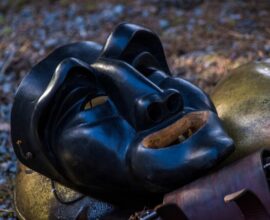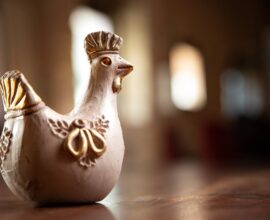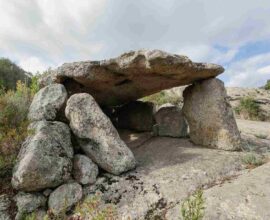Officinal herbs from Sardinia: a journey of nature and health
Discovering the sardinian officinal herbs, a unique and precious natural heritage
Helichrysum, myrtus, ferula and wild thymus are some of the wonderful officinal herbs to be found in Sardinia, plants with impressive healing properties that boast a rich and varied local cultural heritage.
Since remote ages, man has established a deep bond with the plants world, learning to recognize its properties and potential in nutritional, therapeutic and symbolic terms. Hence, medicinal or officinal herbs are a particularly fascinating example of how nature provides effective answers to human needs, who over millennia have been able to intertwine mystic knowledge, empirical observation and popular tradition to shape a system of knowledge to transform “simple” plants into precious means for the care of mind and body. A precious heritage that has taken different forms around the world, which in Sardinia has expressed itself with particular intensity and originality.
Thanks to its isolated geographical position, the Mediterranean climate, mild and pleasant all year round, and the extraordinary variety of natural environments, from rocky coasts to inner lands covered with woods, yet arid plateaus and humid valleys, the ancient island of Ichnusa preserves one of the richest plant biodiversity in the Mediterranean, which favored the development and conservation of unique aromatic and medicinal herbs.
These, carefully hand-picked and used according to practices handed down for generations, initially only in oral form and later even in documents, played for a long time – and still today – a key role in Sardinian folk medicine, with natural remedies for a wide range of health issues from common daily ailments, such as headaches, muscle pain and digestive disorders, to more severe conditions such as respiratory problems or skin infections.
For example, hypericum was used to soothe wounds and burns, while helichrysum was used to treat coughs and bronchitis. Similarly, plants like wild fennel and thyme were appreciated for their digestive and purifying properties. Moreover, preparations based on rosemary and lavender were used as skin tonics and to stimulate hair growth, while sage’s astringent properties were used to treat oily skin and acne, often intertwined with beauty rituals.
Alongside herbal knowledge, often exclusive prerogative of healers, midwives and elders, a more spiritual and ritual dimension of the use of herbs developed by making nature not simply functional, but inhabited by forces to be respected, honored and invoked. Even today, despite modern medicine and pharmaceutical products, many natural practices survived – in renewed forms – and arouse growing interest both from scholars, botanists and therapists, and all those seeking more conscious and sustainable approaches to health care.
In a time in which the connection with nature appears increasingly fragile and compromised, rediscovering the value of officinal herbs, especially those growing spontaneously in little-contaminated places such as Sardinia, means reflecting on alternatives of inhabiting the world, in balance with its pace, resources and life cycles, and learning to explore a territory with its rich cultural heritage and knowledge under new, enriching perspectives.
What are officinal herbs and why they’re used in phytotherapy
Officinal herbs are plants with specific active ingredients, concentrated in roots, leaves, flowers and seeds which bring specific medical and therapeutic properties, that made them the protagonists of an ancient art, phytotherapy – from the Greek phytón (plant) and therapeía (cure), precisely a “cure through plants” – which exploits their benefits to treat and prevent many physical and psychological disorders and support well-being in a “gentler” way than traditional drugs, even more effectively.
Over the years, officinal herbs have been used in many cultures as a natural remedy for a wide range of ailments: the treatment of inflammation, respiratory and digestive disorders, support to the nervous system, strengthening immune defenses and improving liver and lungs functions. Phytotherapy, indeed, is not just an empirical use of plants but explores a deep knowledge of their chemical and pharmacological features, for a more targeted and conscious practice.
Even in contemporary medicine, interest in medicinal plants is constantly growing: scientific research confirms the effectiveness of plant compounds, integrating them in complementary or alternative therapies, especially for who prefers natural supports, less invasive and more respectful of the physiology of the body. Precisely for this reason, they find space in herbal preparations and in many supplements, cosmetics, natural perfumes and multiple wellness treatments, contributing to a more holistic and sustainable vision of health.
How to use officinal herbs and why they’re effective?
Officinal plants are used in many formats depending on therapeutic needs. Some of the most common methods of use are:
- Infusions and teas: liquid extracts obtained by boiling or infusing parts of the plant in hot water. Ideal for extracting active ingredients from leaves, flowers and roots;
- Essential oils: concentrated extracts from plants, used for massages or aromatherapy, thanks to their ability to penetrate skin and act directly;
- Ointments: preparations that combine medicinal herbs with vegetable fats or oils, used for topical applications for inflamed or irritated skin or muscular issues;
- Capsules and pills: for a more precise dosage, practical and hygienic method of use, especially in prolonged treatments or when accurate control of dosage is necessary. Furthermore, by protecting the active ingredients from oxidation and degradation, they maintain the effectiveness of the phytocomplex, while ensuring greater stability and duration of the product;
- Tinctures: concentrated liquid extracts obtained by macerating plants in alcohol, used for targeted treatments on specific parts of the body, or for oral intake.
The effectiveness of medicinal herbs lies in the presence of bioactive substances, such as flavonoids, alkaloids, tannins, saponins, essential oils and polyphenols, which act in synergy on human body, stimulating or modulating physiological functions. Unlike synthetic drugs, often based on a single active molecule, plant phytocomplexes offer a broader spectrum of action to be combined with each other based on specific needs.
Their beneficial effects extend to many health areas, as proven by the following properties:
- Anti-inflammatory: many plants reduce inflammation and symptoms related to acute or chronic conditions. For example, devil’s claw (Harpagophytum procumbens) is used to relieve joint and muscle pain related to arthritis, while mallow is used for its soothing properties on irritated membranes;
- Antioxidant: the presence of polyphenols and flavonoids allows herbs to neutralize free radicals, slowing down cellular aging and reducing the risk of degenerative diseases. Sage and rosemary are well known for their high rate of antioxidants;
- Antibacterial and antiviral: many plants have compounds to hinder the proliferation of bacteria, viruses and fungi, making them valuable allies of the immune system. Echinacea, for example, is known for its immunostimulant action, while thyme has a powerful antimicrobial action, especially for the respiratory system;
- Sedative and relaxing: plants such as lavender, chamomile or lemon balm have been used for centuries to promote relaxation, hinder insomnia and reduce anxiety and stress. Their effects on the central nervous system are delicate but effective, thus represent a natural alternative to synthetic sedatives;
- Digestive and purifying: some herbs stimulate bile production, promote intestinal peristalsis and help purify body from toxins. Peppermint, for example, is useful for slow digestion or abdominal swelling, and artichoke is used in purifying preparations to support liver function.
Learning to use officinal herbs in a conscious and intentional way is the result of long years of study, as well as an empirical and practical approach, shaped by “popular” knowledge that is widespread in places like Sardinia, where medicinal plants are abundant, an integral part of many aspects of people’s lives, from body care to medicine and even gastronomy.
Officinal herbs: list of the most popular and used in Sardinia
In Sardinia, ancient knowledge related to the use of these precious officinal herbs has been intertwined since forever with a wild and pristine landscape, where floral biodiversity has favored the spread and enhancement of numerous plants with powerful therapeutic effects, many of which are still collected, studied and used according to ancient local customs.
Here is a list of the most loved, widespread and used in Sardinia:
1. Helichrysum italicum
Sardinian helichrysum is one of the great icons of the Mediterranean nature. In fact, it grows wild along the coasts of Sardinia, combining the beauty of its golden flowers with impressive therapeutic properties, and its presence on the island has been part of phytotherapy local tradition and ancient healing practices for centuries.
- Botanical characteristics: helichrysum is a perennial plant, with a bushy shape and woody stems that reach the height of about 60 cm. Its leaves are narrow, linear and silvery green, giving the plant a distinctive appearance in the sardinian landscape. The flowers, intense golden yellow, are gathered in small bouquets that rise above the foliage. The peculiarity of helichrysum is that, once harvested, it retains its color and scent even after drying, thus is often used in decorations of flowers;
- Habitat and distribution in Sardinia: helichrysum grows in coastal areas, where the soil is sandy and well-drained. It prefers dry soils, found in areas exposed to sunlight, such as cliffs and hilly areas. It’s particularly abundant in southern Sardinia and the smaller islands, where the plant finds an ideal environment to thrive;
- Traditional uses and medicinal properties: the flowering tops of helichrysum are used to make extracts with strong anti-inflammatory and healing properties. In Sardinia, its infusion is used to treat respiratory infections, like bronchitis and coughs. Thanks to its expectorant properties, it is excellent in promoting the elimination of mucus and in alleviating symptoms of colds and flu. Furthermore, its soothing properties make it a popular remedy for sunburn and skin irritations, while its ability to deeply regenerate the epidermis makes it a valuable anti-aging treatment;
- Cultural and symbolic aspects: in popular culture, it was believed that helichrysum protected from negative energies, indeed it was often burned for purification rites to bring good luck. The plant is also symbol of longevity, as in addition to being resistant to difficult climatic conditions, it can be used both fresh or dried without losing its properties. This symbolism, related to an imagery of resistance and strength, is truly exemplary of rural life and its deep bond with nature that has always characterized the Sardinian folkloric and cultural scene.
2. Artemisia arborescens
Known since ancient ages for its therapeutic properties and intense scent, like resin, shrubby absinthe, also known as sea absinthe, is an integral part of the island’s folk medicine, a herb that accompanies the daily life of those who live in touch with wild nature, that grows freely along the coasts and hills of Sardinia.
- Botanical characteristics: sea absinthe or artemisia is a perennial shrub that can grow up to 2 m in height. Its leaves are gray-green with a characteristic strong and resinous smell, while its small yellow flowers emerge from the woody branches of the plant. The stem is robust and lignified, to resist salty winds and poor soils, typical of coasts;
- Habitat and distribution in Sardinia: the presence of this plant is related to the coasts, where it grows on sandy and arid soils. The plant loves areas exposed to sunlight, near cliffs, salt meadows and along rocky coasts, where the sea breeze accentuates its characteristic scent. Artemisia or absinthe is widespread throughout Sardinia, but is particularly present in the southern and western areas;
- Traditional uses and medicinal properties: renowned for its tonic and antispasmodic characteristics, which stimulate the appetite and support digestive processes. An infusion based on its leaves is particularly effective in countering gastric disorders such as nausea, bloating and abdominal stiffness. It’s appreciated for its ability to stimulate immune system, frequently used to relieve flu symptoms with its purifying and invigorating action. In Sardinia, the plant takes on a symbolic and cultural value, protagonist of the preparation of traditional spirits, like the well-known “absinthe liqueur”, in which its aroma combines with its digestive effects for a product with a unique flavor and multiple beneficial properties;
- Cultural and symbolic aspects: in Sardinia, sea absinthe has always had a magical and protective meaning, asits leaves were collected and burned for purification rites, or used as amulets. The plant is related to the personality of Sardinian shepherds, who always used it as a natural remedy to cure many ailments.
3. Thymus herba-barona
Sardinian wild thyme, known scientifically as Thymus herba-barona, is a plant that embodies the purest and most authentic essence of sardinian nature, perfectly reflecting the wild and untamed spirit of the island. It grows spontaneously among rocks of the coasts and in the arid meadows within the inland hills, where its small and aromatic leaves stand as testimony to the resilience and strength of the Mediterranean flora. The balsamic aroma it emanates, result of its high concentrations of thymol and carvacrol, makes Sardinian thyme a unique plant combining the charm of uncontaminated nature with everyday usefulness.
- Botanical characteristics: Sardinian wild thyme is a small perennial shrub that grows as a compact bush. Its leaves are small, linear and silver-grey green, and emanate an extremely aromatic scent, while its flowers, pink or lilac, gather in inflorescence. It loves sun and dry rocky soil, hence this plant is particularly adaptable to different climates and grounds;
- Habitat and distribution in Sardinia: wild thyme is a plant endemic to Sardinia and is widespread throughout the island, although it is particularly abundant in the inland areas, on hills and arid calcareous soils. It grows in dry meadows, along paths and among rocks, where it thrives despite tough climatic conditions;
- Traditional uses and medicinal properties: thyme leaves and flowering tops are rich in thymol, an aromatic compound that gives the plant powerful antibacterial, antifungal and anti-inflammatory properties. It is used in infusions to treat sore throats, coughs and bronchitis, with its calming action on the respiratory tract. It’seven a powerful digestive support, used to relieve common gastrointestinal disorders. In cooking, wild thyme is used to flavor meat, fish and vegetable dishes, even to preserve foods;
- Cultural and symbolic aspects: in Sardinia, as in many other Mediterranean cultures, wild thyme a symbol of purification and protection, used in many rituals to ward off negative energies and promote a healthy environment. It’s no coincidence that it was traditionally put in small bags hanging outside doors to keep the evil away. Its ability to thrive in harsh environments makes it an icon of resilience and perseverance, too.
4. Myrtus communis
Myrtle or Myrtus is much more than a simple official herb, it represents a true symbol of Sardinian botanical, gastronomic and cultural identity. Its rich presence in hilly and coastal areas of the island, combined with its unmistakable scent and its many properties, has made it one of the most recognizable icons of the Mediterranean flora, a sign of the strength and resistance of Sardinian nature. But it’s not limited to its use as an aromatic and medicinal plant, indeed it extends to the preparation of the most representative liqueurs of Sardinia, “mirto”, an ancient traditional distillate mainly produced with artisan methods, following recipes handed down for generations.
- Botanical characteristics and habitat: an evergreen shrub, compact and branched, myrtle can reach up to 3 m in height. Its elongated, leathery and shiny leaves are intensely aromatic, while its delicately scented white or pink flowers turn into dark blue-purple berries in autumn. It grows spontaneously in dry sunny soils, especially in well-drained calcareous or siliceous grounds, everywhere from sea level to hills;
- Traditional uses and properties: myrtle has always been used for its antiseptic, digestive and anti-inflammatory properties. In phytotherapy, its leaves and berries are used to prepare infusions, teas and essential oils with a balsamic action, useful to soothe respiratory and gastrointestinal disorders or inflammation of the urinary tract. The berries are the basis of the famous myrtle liqueur, one of the iconic products of the Sardinian food and wine tradition, traditionally produced in two variants, red or white, depending on the type of preparation and berries. Its production is still largely artisan today, keeping a tradition bound to popular practices that combine ancient knowledge with modern distillation techniques;
- Cultural and symbolic aspects: myrtle was considered sacred in ancient Greece, and in Rome it was associated with Venus, goddess of love and beauty. In Sardinia, the plant retained a deep ritual and symbolic value for purification and protection. The leaves were burned to perfume rooms or hung as a talisman against the evil. Even today, it’s present in folk ritualslike traditional marriage and the blessing of houses on particular religious celebrations, such as Easter.
5. Ferula communis
Imposing, austere, full of mystery, Ferula is one of the most fascinating plants in Sardinia. Its highly scenic presence, with stems up to 2 m high and flowering umbrellas that dominate the fields in spring, has always influenced folk tales, magical beliefs and a sense of reverence towards this plant both “sacred and dangerous”.
- Botanical characteristics and habitat: perennial herbaceous plant belonging to the Apiaceae family, ferula has an erect, robust and hollow stem, similar to a stick, which ends in large yellow inflorescence. It grows in arid marginal areas, at the edges of rural roads, abandoned or uncultivated lands. It prefers sunny environments or poor soils, calcareous and sandy, where it grows properly;
- Traditional uses and precautions: in folk medicine, ferula is used for its expectorant, carminative and antispasmodic properties. Its resinous sap, similar to oriental asafoetida among the most used spices in Ayurveda, was collected and used to soothe respiratory issues and muscular pain. The plant must be processed with extreme care: some varieties of Ferula indeed contain toxic ingredients, that cause even severe gastrointestinal disorders, especially in cattle;
- Cultural and symbolic aspects: in Sardinia, ferula was often associated with rites of protection, purification and “magical” medicine. Shepherds considered it a plant with ambivalent properties, both healing and harming depending on its use. The sticks obtained from the dry stem were used as ritual tools or as supports in everyday life, to build chairs, stools and other things, yet for maturing cheeses or sausages. In rural areas it also used to be burned to drive away illnesses and negative influences, thus combining the therapeutic dimension with the spiritual one.
6. Lavandula stoechas
Harmonious, fragrant and delicate, Lavandula stoechas, commonly known as wild lavender, is one of the most loved and iconic aromatic plants of the Mediterranean. Its ability to grow in poor soils and its intense scent make it a silent, powerful companion in Sardinian rural life.
- Botanical characteristics and habitat: a perennial plant of the Lamiaceae family, wild lavender is distinguished by its compact, deep purple flower spikes with a unique ornamental appearance. The leaves are grey-green, narrow, covered with light peach fuzz. It is widespread in arid and sunny soils over the island, especially the hillsides, among low shrubs and bushes;
- Traditional properties and uses: always appreciated for its calming, anti-inflammatory and antiseptic properties, lavender was used to prepare relaxing infusions, scented small packets to keep under the pillow to promote sleep or to aromatize wardrobes and drawers. Its essential oil, cold-extracted, was used for massages, muscle friction and to soothe rheumatic pain or burns. But it’s often used even to calm anxiety and regulate mood;
- Cultural and symbolic aspects: in Sardinia, wild lavender was considered a plant “of peace and balance”, used in rituals of passage and moments of family tension. It was burned in homes to purify the atmosphere or spread in newborns cradles to protect them from the evil. An icon of femininity, intuition and delicacy, it has remained over time a silent ally especially for women who learned its therapeutic secrets.
Discovering the wonderful sardinian nature and officinal herbs at Forte Village Resort
Respect and protection of the rich and varied natural biodiversity of Sardinia, including the wonderful and abundant officinal herbs on the island, have always been milestones of the philosophy of Forte Village, a five-star tourist facility near the wonderful beaches of Santa Margherita di Pula, recently awarded as “the most beautiful resort in the world” – for the twenty-sixth time in a row – at the World Travel Awards held last December in Madeira.
The Resort has in fact recently achieved, for two times in a row between 2023 and 2024, the prestigious GSTC (Global Sustainable Tourism Council) certification, a recognition awarded to destinations and tourist facilities that respect criteria of environmental, social and economic sustainability, including the management of natural resources, the protection of cultural heritage, and respect for local communities.
Furthermore, the Sardinian Resort actively supports ambitious initiatives such as Fishing For Litter (“waste fishing”), a project carried out in collaboration with Ogyre, Italian startup that commits to maintaining seas clean, which relies on support by the local fishing community. The ultimate goal is to collect wastes trapped in nets during fishing activities on high seas, thus taking concrete action to preserve the beauty of Sardinian sea, the most pristine in Italy.
A commitment to sustainability not limited to protecting the environment or enhancing the territory, but which finds full expression in the gastronomic offer by Forte Village, too. With over twenty-one restaurants – including excellences like Belvedere by Giuseppe Molaro and Beachcomber by Heinz Beck – the Resort promotes a sustainable, conscious and respectful diet, based on local, seasonal and top-quality ingredients.
Many of these ingredients come directly from the educational garden within the spaces of the Resort. Here, each plant grows with care and in full respect of the paces of nature, to be harvested only when fully ripe and used immediately in cuisine. It results in food creations that tell the story of Sardinia through its scents and colors, opening to experimentation thanks to proposals that intertwine with the fascinating universe of fusion cuisine. A concept of gastronomy that celebrates the territory and dialogues with the cultures of the world – without ever losing sight of authenticity, quality and love for the homeland.
In other words, the best place to relax, discover local botanical gems, enjoy excellent food and contribute, doing your own little part, to protecting environment and traditions.
For further information about the novelties for season 2025 at Forte Village Resort or for booking a reservation, please call to +390709218818 or write to holiday@fortevillage.com.
Do you want to experience a fairytale holiday in an authentic paradise? Discover Forte Village Resort in Sardinia






